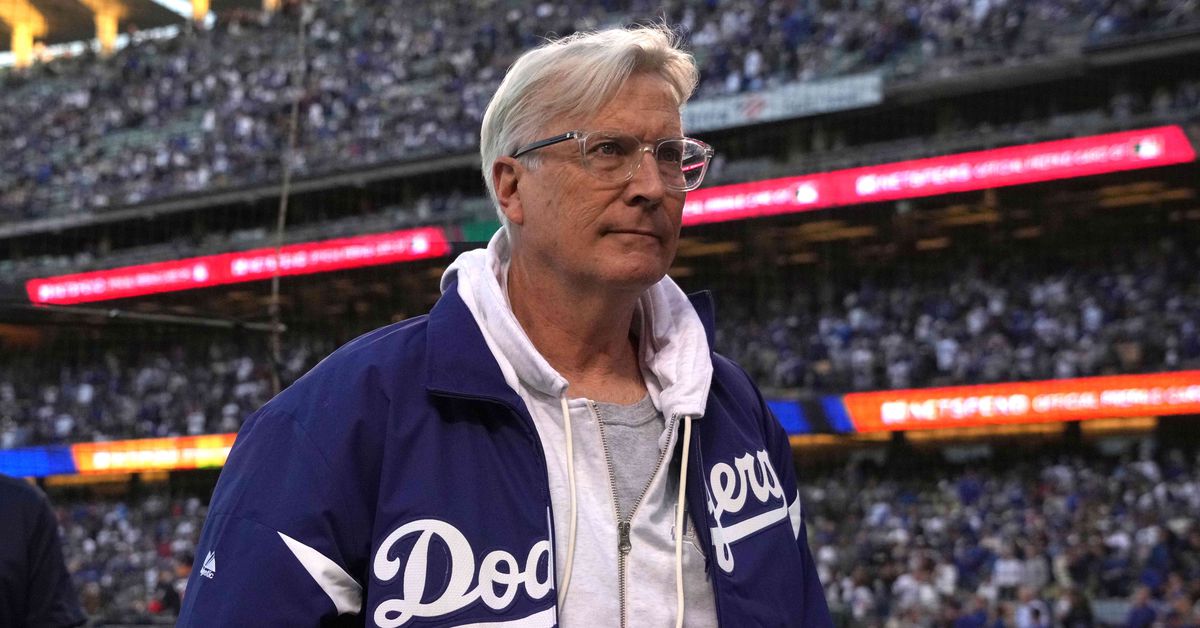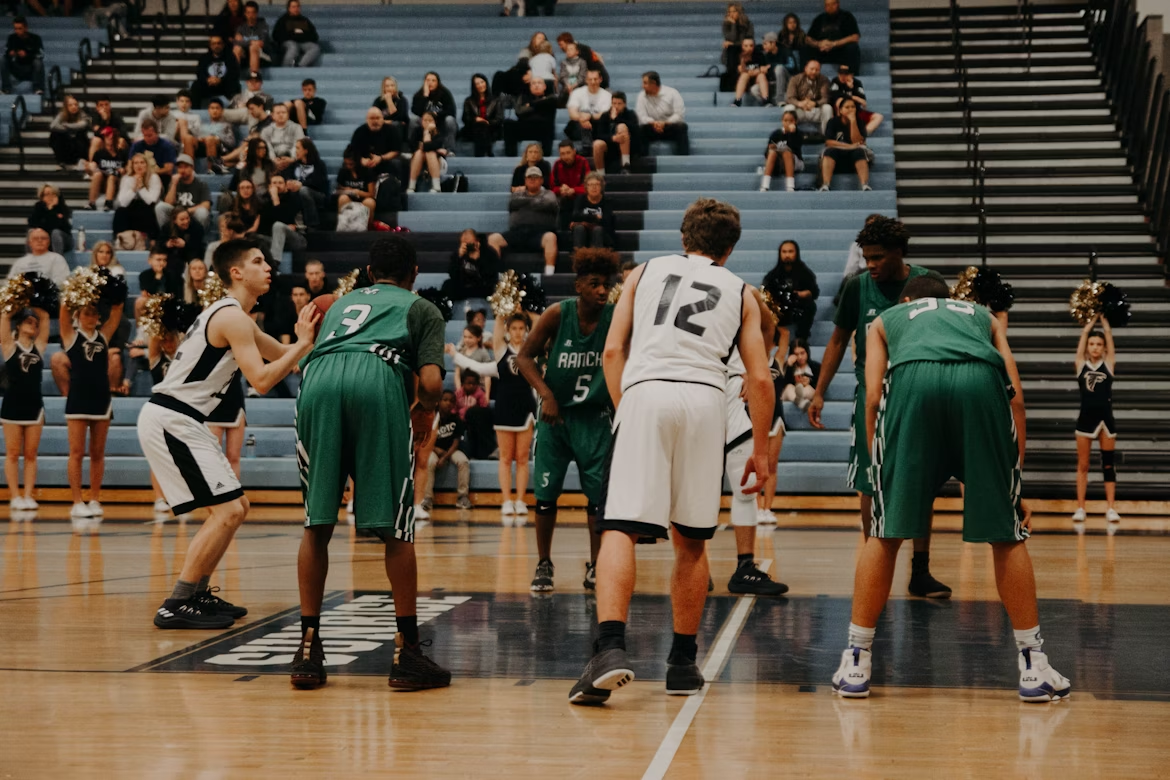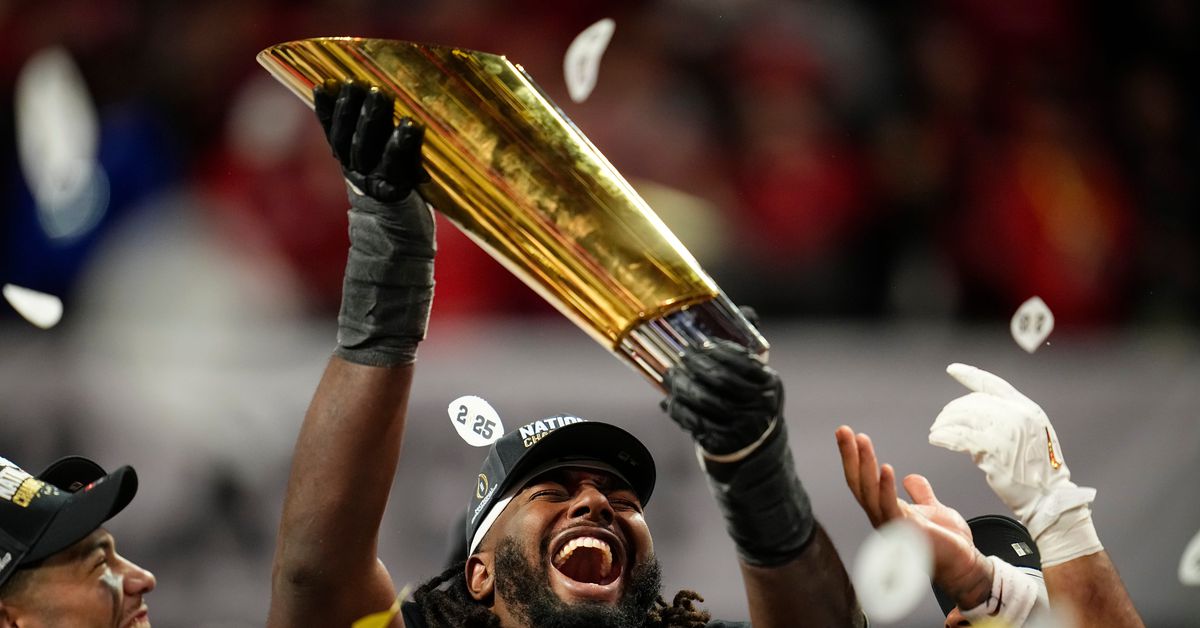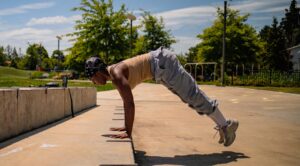Quacking the Roster: Oregon Ducks Defensive Line Transfer Bear Alexander
Thanks to Michael Darke of the Nothin’ Finer podcast and Alicia de Artola Castillo of Reign of Troy for helpful conversations clarifying some background information for this article.
Alexander was originally recruited to Georgia in 2022 as a high 4-star (.9782) in the 24/7 composite. As a backup, he saw the field in all but three games of the Bulldogs’ 15-0 championship season, missing only the matchups against Oregon, Tennessee, and Kentucky. Like most true freshmen in Coach Smart’s developmental progression system I’d observed for a couple cycles while studying the team for the opener, Alexander almost exclusively came in late for mop-up duty — of which there was quite a bit since their average margin of victory that year was four touchdowns — though he got a couple of meaningful reps at the end of the second half in two games.
After the national championship, Georgia had one of their defensive line starters, Jalen Carter, drafted in the 1st round, but remarkably the other seven members of the full rotation returned for 2023 Spring practices. Despite two of those linemen getting substantial meaningful play right behind the starters in 2022, Alexander was widely understood to have jumped them and was going to take Carter’s spot as the new starter next to Nazir Stackhouse. In a surprise, Alexander announced he was entering the transfer portal on the final day of practices and didn’t participate in that day’s Spring game. A week later he committed to USC and enrolled in the Fall. (After some jostling, Warren Brinson wound up with the starting job instead for the 2023 and 2024 seasons; he’s been fairly effective but some Georgia fans were left to wonder what might have been and I’ve found no suggestion that Brinson chased Alexander off.)
Alexander immediately became a starter in Los Angeles and it was readily apparent to non-allied observers at the time that he was not only a substantial upgrade on the Trojans’ previous and surrounding d-linemen, but quite possibly the sole defensive player performing at a high or even acceptable level for then-DC Alex Grinch’s entire squad. He started all 13 FBS games and was in on about 71% of meaningful snaps prior to garbage time in 2023, which unlike Georgia constituted almost all of USC’s games as they were not blowing out opponents by multiple touchdowns in their 8-5 season.
In early November of 2023, Coach Riley fired Grinch and ultimately replaced him with DC Lynn — who’d spent 2023 at UCLA running a fairly different style of defense — for the following year. In previewing USC’s 2024 season, I expected Alexander to start but was skeptical of the other defensive tackles on the roster I’d seen in Spring practices as the rest of the unit was longtime backups with negligible playing time and two lower talent-ceiling transfers whose previous tape hadn’t impressed. I attributed Alexander’s limited participation in the Spring game to a minor injury, and so I was shocked to see in the Fall opener that he had been relegated to the second string behind those transfers, and a reduction in playing time during the first three games of 2024 to 39.5% of meaningful snaps.
After the third game in September, Alexander communicated to the media through a representative that he wouldn’t play for the rest of the season to preserve his redshirt, and that he planned on staying with USC to the end of the year for practices. In December he entered the portal and committed to Oregon. Alexander has two years to play two of eligibility remaining.
Throughout the 2023 season as a starter and for his five dozen meaningful reps as a backup in 2024, Alexander’s grades on my tally sheet are exceptional. He achieved backfield penetration within two seconds of the snap on 74.3% of his reps, either personally stopped or tangibly affected the play (e.g., hurried the pass, re-routed the run, flushed the QB, etc.) through defeating a block on 79.1% of them, and had an overall positive play rate in which he did his job properly in the structure of the defense 90.9% of the time. These numbers are at the top level of the best interior defensive linemen I’ve charted over the years, comparable with multiple players who’ve gone on to be early-round draft picks or are projected to be this month.
In comparative cohort analysis, Alexander’s presence or absence on the field had significant measurable effects on defensive performance in almost all areas:
:no_upscale()/cdn.vox-cdn.com/uploads/chorus_asset/file/25931185/USC_defense.png)
In pass defense, Alexander’s effect is very clear: more than three percentage points improvement compared to when he’s off the field in the defense’s ability to stop efficiency passes, two and a half points off the offense’s explosive passing rate, and about three quarters of a yard less per pass attempt. It’s across the board in the down & distance passing figures as well, ranging from a two-point bump on 1st downs to between seven and nine points up on 2nd downs to almost a 20-point improvement on 3rd & medium or long.
With rush defense, the efficiency effects are even more stark at a massive six-point improvement, although the adjusted YPC and explosiveness figures don’t change much. The down & distance figures illustrate why, and picked up on a phenomenon I caught while watching film and called the “run away from BA” effect. While Alexander’s presence massively improved USC’s short-yardage rush defense figures, by over 30 points in some categories, offenses actually succeeded somewhat more often when they ran the ball on 1st down with him in the game.
This wasn’t because he had a unique problem on 1st downs, but because in that situation (unlike short-yardage, when they’d try to go up the middle and right at him, fruitlessly) opposing offenses would see Alexander and run to the outside, against the rest of USC’s defense. This would often produce very big plays because those defenders were atrocious, whereas on 1st downs when Alexander was taking a break and other DTs were in, offenses were more likely to take their chances up the middle and find relatively more resistance. That is, even though the DTs not named Alexander weren’t as effective as he was, they were still more effective than the safeties and other perimeter defenders. So Alexander’s presence on 1st downs, but not other downs, had the perverse effect of scaring offenses into better rushing strategies.
Alexander’s most notable comparative overperformance area is one-gapping in late-down pass defense, in which his superior backfield penetration and havoc generation grades next to his cohort generated the maximum impact. Remarkably, there’s no significant difference in his grades depending on what spot on the line he took, from head-up 0-tech out to a wide 5-tech, and there’s a considerable variety to his film. Some examples:
(Reminder – you can use the button in the lower right corner to control playback speed)
- :00 – Alexander is in jersey #90, as in all clips, here as the 4i off the RT’s inside shoulder. USC backs out of the blitz to only send three and Arizona slides to pick up the stand-up end, so Alexander crosses the RG and fires inside of him, splitting the protection before the C can figure out he should help. The QB doesn’t have a chance to set up and the ball flutters.
- :12 – Here he’s the 3-tech between the LG and LT. This is a pretty long-developing sim which is going to take a while to get home but Alexander has crossed to the C with shoulders square to the line and puts him on skates, then works an arm free and into the QB’s passing space which affects the throw. It’s a wobbler which lands harmlessly.
- :20 – Now the line is in a Tite formation with Alexander as the nose. The LG clearly expected another moment to assess the rush but this is a mistake with Alexander coming, he’s immediately in the backfield off the snap with a great burst, and gets to the QB with the ball still in his hand. Contact is appropriate, chest to shoulder, heads are out of it, no excess.
- :30 – On this play he’s lined up as the 2i, shaded just inside the LG’s shoulder. Alexander bullrushes him straight back seven yards into the QB’s lap, forcing him to panic and try to quit the pocket. Note how Alexander’s head is up, not buried in the guard’s chest, throughout the engagement so he can monitor the QB, then shed the block when needed and wrap up the QB in a form tackle. The official scorekeeper did not mark this down as a sack for some reason.
On most passing downs, Alexander was lined up in the 3-tech or wider, sometimes the 2i. Here’s a representative sample of his performance compared to the rest of the USC defense on such reps:
- :00 – Alexander feels the line dropping out and so re-traces, figuring out the screen about three seconds before the rest of the defense. He has the ballcarrier wrapped up and almost to the ground before his teammate intervenes.
- :19 – Here he’s the 3-tech between the RG and RT, defeating the guard first on a shove and rip move and then his attempt at a hold. Alexander flushes the QB whose downfield options are limited, until the LB decides to leave his coverage on the TE and attempt a sack from 20 yards deep.
- :39 – Alexander is the 4i shaded off the RT. He beats the tackle outside as the QB tries to slide out of the pocket, forcing an awkward throw on the shallow crosser short of the sticks on 3rd & medium. This should be an easy stop for the next level of the defense, but the linebacker is out to lunch and the safety elects to tackle a receiver who didn’t catch the ball.
- :48 – I acquired the all-22 of UCLA’s 2023 offense for a different project but it proved quite useful for this one. The high angle shows that after defeating the RG, Alexander demonstrates awareness of the play design by getting wide and into the throwing lane for the first three routes of the pattern. After the QB is flushed by Alexander, he still finds an outlet for the conversion on the fifth read as the backers are defending grass.
At 2.31 sacks per game in raw stats, USC’s sack production in 2023 was fairly mediocre considering the near-constant backfield penetration from Alexander. From watching tape, I think there were a couple things going on. First is that Alexander doesn’t look to me to have elite wingspan — probably the one aspect of his dimensions for a lineman that will get a ding by pro scouts — and I’ve seen a few potential victims escape his reach. Second is that there never seemed to be any kind of coordinated rush plan or lane discipline from the Trojans’ defense, so getting into the backfield was far from a guarantee of anything, especially against nimbler Pac-12 QBs. Some examples:
- :00 – Great penetration here but if the DE is going outside and the other DT is taking on the C-LG combo then somebody has screwed up their lane discipline. It’s impossible to say without knowing the actual rush plan (I suspect the DE is just getting too deep and is supposed to hang back, but it could be on Alexander making an inside move), but nobody would draw up a gap this big.
- :08 – This one is on Alexander trying to do too much, the end has whipped the LT and it’s Alexander’s job to stay square on the LG so he can go either way that the QB scrambles. When he turns his shoulders perpendicular to the line chasing the QB on that initial move up the A-gap, he gets trapped and can’t recover when the QB reverses and there’s no one to stop him.
- :17 – I don’t think there’s a rush plan at all here, I highly doubt this is a planned tackle stunt and suspect Alexander is just attacking however he feels is going to get through fastest. With the right B-gap unoccupied, the other DT trapped by the guards, and the LBs backed out, the QB gets a substantial gain.
- :24 – Alexander rocks the center and panics the QB into bailing instead of just sliding to his left where the line has contained the other, far less worrisome DT. Alexander gets both hands on the QB as he runs past but doesn’t get a good grip and the QB escapes, though is marked short of the conversion.
In rush defense, Alexander’s differential grades over his cohort are most pronounced in short-yardage run stuffing and late-down TFL production. As with pass havoc generation, these grades appear agnostic to technique. Some examples:
- :00 – Alexander is the nose in a Tite front, he crushes the center two yards back off the snap then sheds him and wraps up a future UW star tailback going for the right A-gap, single-handedly making the play on 2nd & long.
- :06 – The back tries to escape to the right after Alexander swims the LG to the outside but he’s simply too fast crossing the backfield, and what a perfect wrap-up.
- :13 – I count the RG starting 10 frames early on 29.97 FPS film, which I suppose both the officials and the Joe Moore award committee missed but Alexander didn’t as he cracks the snap count and gets into the void, beating the C and cutting off the RT’s pull. The back trying to stiffarm him was especially amusing.
- :31 – Here Alexander is the 1-tech over the C’s right shoulder. He knocks that guy right over, using him as a human projectile to take out the slicing TE, and spins down the tailback four yards in the backfield.
On standard downs, USC typically deployed Alexander inside the guards — as a two-gapping nose, a 1-tech, or a 2i — expecting to use him to stop or redirect the run. Here’s a representative sample of his performance against the rest of the USC defense in those situations:
- :00 – This game was interesting because SJSU has some of the similar — and unusual for modern college ball — schematic run concepts as USC does like this power read. Alexander starts over the LG but the C has his assignment, though it doesn’t go very well for the snapper. With the RB spilled wide it would just take one of the playside end, backer, or safety to get their angles right to finish this play off, but alas. The DC is chased from his spot on the sideline, prophetically.
- :10 – This might be the most humiliating swim move from a 1-tech I’ve ever seen. The RG has to take all of Alexander and the backers are totally clean, so there’s six blocking four and no interior lane, and no over-the-top safety needed to contain a deep pass threat because it’s a direct snap. This should be an easy bounce to kill on 3rd down … but the end never sets the edge in Grinch’s defense, the backers always bite, and the safeties coach is worse at his job than the DC.
- :25 – Here’s Alexander two-gapping, eventually getting through playside once the back puts his foot down. The penetration re-directs the play to the C-gap, which should be shut down by the end setting the edge, but see above. The rest of the run is USC tackling of a back that some teams but not others found difficult to bring down.
- :45 – One of the many “run away from BA” plays on my tally sheet; he’s crushed the center from his nose spot into the backfield, far enough that it even affects the pathing of this outside run and given the speedier edge rusher a shot at the TFL. But this is the wrong angle of pursuit, the end needs to string this to the sideline instead. The rest of the defense has been suckered by the presnap motion. The converted safety escapes one defensive lineman, but not Alexander running him down.
One of the metrics I track from charting seasons is turnover share, which measures how big of a role each defender played on a per-down basis in generating interceptions and fumbles recovered by the defense. Alexander’s 2023 season was one of the highest individual scores in turnover share I’ve ever recorded.
Of the ten turnovers USC’s defense got in 2023 during meaningful play from scrimmage (down from 18 with the same qualifications the year before; this significant regression to the mean in turnover luck was predicted by most mathematically informed commentators at the time as the 2022 numbers were unsustainable), I attribute six directly or through major indirect contribution to Alexander. With two others he did his job on the play but he wasn’t really involved in making the turnover happen, and the last two he wasn’t on the field for. There’s a one and one split (made it happen, was on the sideline) of the two turnovers USC got in the first three games of 2024 as well. Here are some examples of Alexander’s contributions:
- :00 – Here Alexander has cracked the snap count and goes right with the ball, executing a great rip tech with his right arm over the RG’s inside shoulder and ripping through fast, quickly enough that the C can’t get his base in front of Alexander and actually block him. The QB panics when he comes out of play-action to see the immediate threat and ditches the ball without checking coverage (the DB didn’t run with the motion man like he hoped).
- :19 – Alexander working the LG as the 3-tech deep into the backfield not only hurries the smaller QB, the replay angle shows he gets a finger on the ball and alters its trajectory.
- :23 – These are the wrong zone blocking assignments from the entire left side of the line, all of which is a reaction to knowing that Alexander is going to destroy the LG (which he does anyway) so the LT and C delay their proper blocks to try and help. Getting caught on Alexander means the C has given the backer a completely free shot on the back, which he uses to punch the ball out. Indirect, but clearly connected to Alexander’s effect on the blocking.
- :55 – Here’s another example of Alexander cracking the snap count to get an immediate jump. He shoves the center four yards into the backfield before the mesh with the RB is even completed. At this point Alexander detaches to pursue the back as though he has the ball, but watch how the LT and TE react to Alexander coming anywhere close to them – they suddenly drop their attention on their own pickup assignment, the blitzing safety. He was effectively cut off but now has the perfect angle to get to the QB and pop the ball free.
There’s been extensive media commentary and speculation on Alexander’s personal qualities, locker room demeanor, and why he’s attended so many high schools and colleges, all of which are outside the scope of film study of on-field play to assess. Some of the narratives I’ve encountered tap into real or perceived penalty issues which can be addressed, however.
Alexander was flagged five times at USC, for three types of things. The first thing is a pair of offside penalties, from jumping too early. This was definitely part of a pattern – on about 21% of Alexander’s reps in 2023 he was clearly attempting to crack the snap count and time his jump exactly at the moment of the snap, and was successful on virtually all of them except for those two occasions (I verified on tape by going frame-by-frame, other than the two flagged plays he got it right and didn’t enter the neutral zone early).
The second thing was also part of a pattern, which was when he’d gotten into the backfield and the QB had taken a deep drop and so had the time to get rid of the ball with no chance that Alexander could sack him properly, Alexander would stretch up vertically while continuing to close on the QB to try and knock the pass down (he got a swat as a true freshman against Auburn doing this, plus another in the week 0 game of 2023 against San José St, but none since then, and my suspicion is that he’s been chasing the experience ever since). The problem is that over the season he’s gone up higher and higher, including leaving his feet and losing control of his body as he comes at the QB. Even if the officials never called it I would have included some clips of this pattern as a caution of the high penalty and safety risk it carries, but as it happens he was flagged twice for it.
The last thing was a one-off, and I can attest that in watching every rep of Alexander’s college career — including garbage time for verification — nothing like it happened at any other point. That flag was for a throwdown of a running back while he was moving laterally down the line of scrimmage but after Alexander had stopped his forward progress and the refs had blown the play dead. (It occasioned a lot of stern finger-wagging from the commentators after the Trojans gave up a touchdown a couple of plays later, which I thought at the time I was watching it live in 2023 misapprehended basic causality.) There were no instances I can report of ever seeing on-field or between-plays conduct from Alexander that struck me as excessive or demonstrating lack of emotional control on the tape I reviewed.
Here’s video of all five penalty flags Alexander received:
- :00 – On this one I think there was no fake signal, I believe Alexander made a guess based on a combination of the playclock and the presnap motion, which it turned out to be incorrect by about a quarter second.
- :17 – This one he bit on the fake clap, the only time I saw that happen … that is, I never saw him jump across the line then jump back before the snap so it went unflagged. This was the only occasion of any outcome that Alexander moved on a fake clap.
- :30 – The LG and LT aren’t handling this T-E stunt well so Alexander gets a free run at the QB. This was the latest and most consequential example of the pattern, he’s so far extended that he leaves his feet while at a full run. I doubt there’s any malice here, he’s probably just trying to get the ball knocked down, but that doesn’t matter as this is dangerous and foolish, carrying a fully appropriate targeting ejection which carried over to the first half of the next game (against Cal, the major reason why the otherwise anemic Bears offense scored four TDs on five full possessions that half).
- :56 – This is an earlier example, which was flagged for targeting then picked up and changed to simple roughing the passer. In my opinion that’s technically the wrong infraction, this shouldn’t be RPS because Alexander makes contact while the ball is still in the QB’s hand (or just about, he certainly doesn’t take even a single extra step), but rather UNR because he’s going high while trying to disrupt the pass. Since the QB’s throwing arm is away from him, the right thing to do practically and for safety is forget about the pass, turn his head and put his shoulder into the QB’s midsection.
- 1:09 – After Utah advanced the ball to the 3-yard line in six big plays (half of which Alexander wasn’t on the field for), Alexander blows up the RG and wraps up the RB in the backfield, but his momentum carries him forward so Alexander pulls him back for one spin along the line of scrimmage. The RG then picks up and starts pushing the RB laterally along the line, and Alexander spins the back again, free of the RG and then down. The short wing had blown the play dead in the middle of the second spin so the throwdown was illegal.
USC’s 2024 defense under DC Lynn structurally resembled USC’s 2023 defense much more than it did UCLA in 2023, although philosophically the Trojans played with far less recklessness. In the three games in which Alexander played, his role and that of the other defensive tackles was substantively the same as the previous year; Alexander simply came onto the field later in the rotation. That means most of the statistical analyses and cohort comparison can be extended to this time in a straightforward manner, though for the sake of video documentation I’ve separated out some representative clips to show that Alexander’s performance was unaffected by the transition:
- :00 – LSU seemed surprised that Alexander had been relegated to a backup role, because their run strategy did not play favorites when the new starters were in, but when the second line was in they ran to the opposite direction of wherever Alexander was every time. Here, just like in 2023, Alexander gets off the block and runs the play down from behind.
- :11 – The LT is trying to pin Alexander on what’s supposed to be an outside run as the LG pulls around him, but he’s destroying the LT’s leverage and forcing the RB back inside. He then sheds the LT’s block and wraps up the RB’s legs to bring him down. The camera angle isn’t very clear on this but Alexander was only in on five designed run plays in this game and this was the best tape of any of them.
- :18 – Customary Alexander pass rush move against an otherwise effective SEC guard, forcing the QB to step up and make an awkward hurried throw to the TE on the crosser which the less poorly coached defense was capable of cleaning up in 2024 to earn a punt.
- :34 – Again, familiar to the 2023 tape, Alexander starts over the LG, crosses to the C, throws him to the ground, moves much faster than the protection expects, and is chasing the QB while the H-back is still figuring out where he is. The QB gets rid of the ball and is nearly picked off.
Share this content:















Post Comment